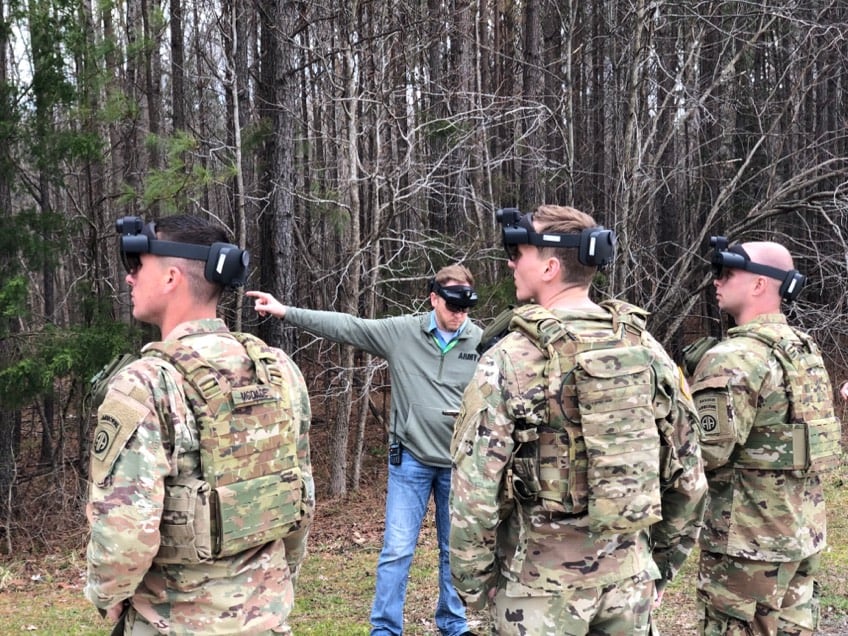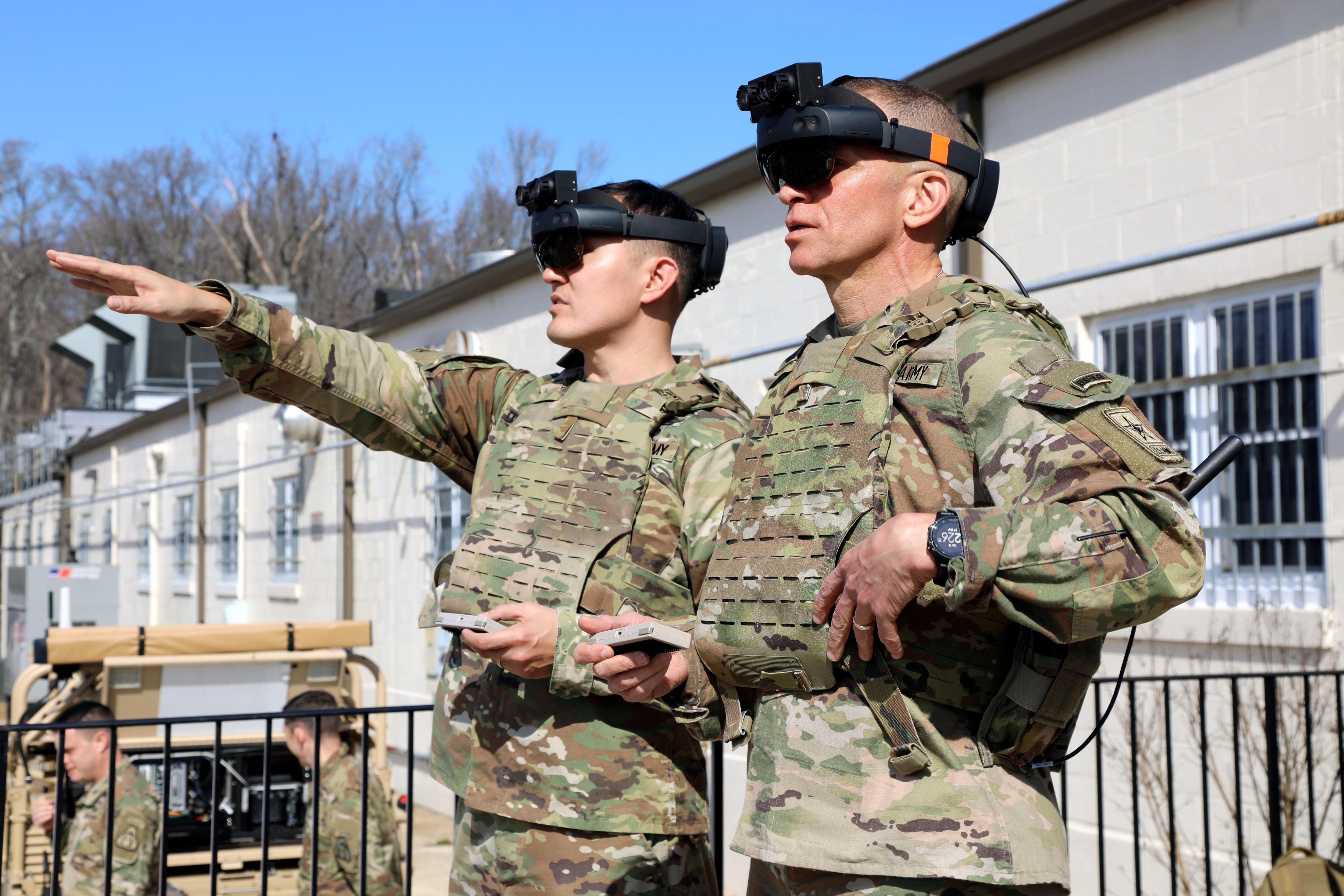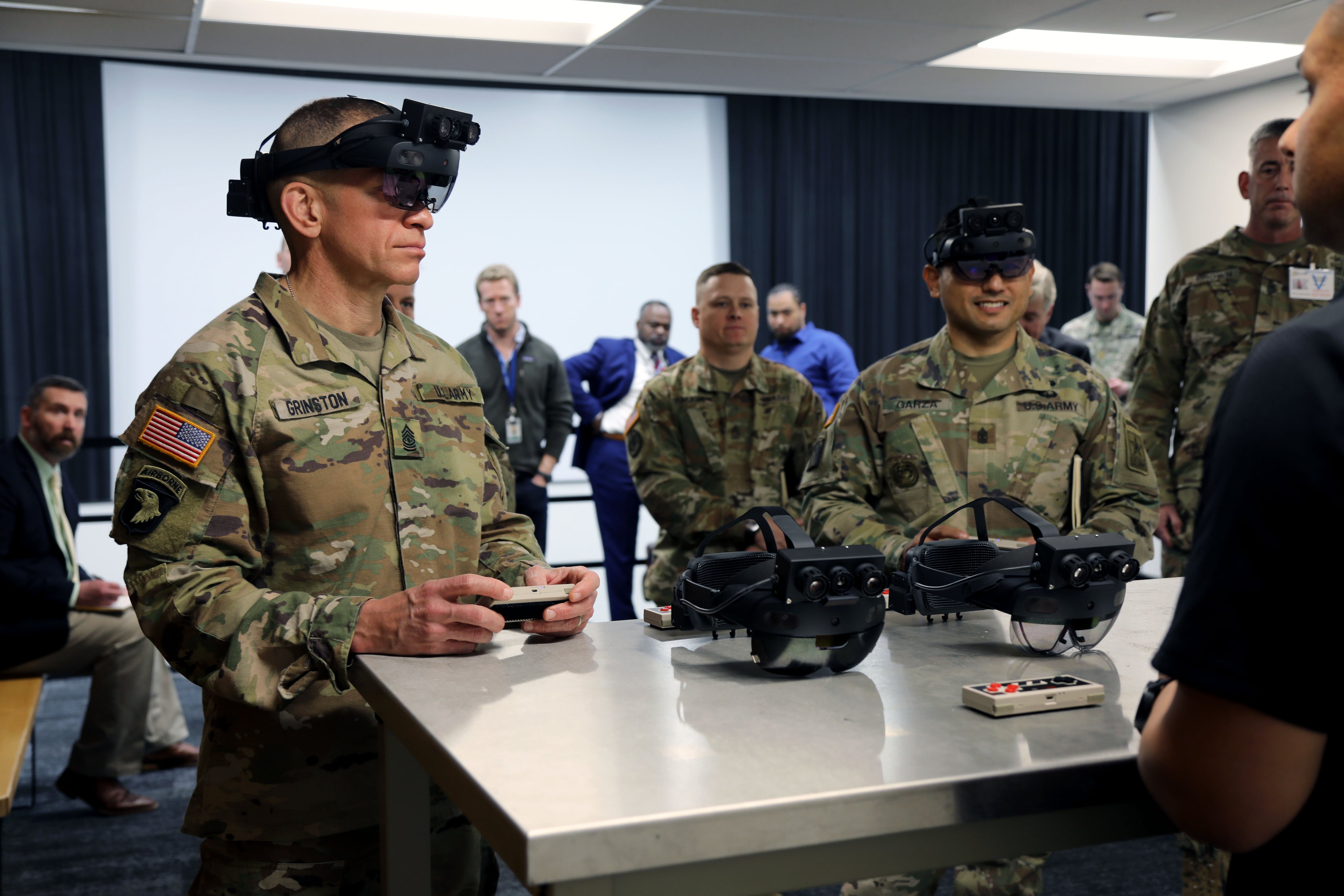FORT BELVOIR, Virginia – Rushing into the room, a soldier sees a dog to his right his attention quickly turns to two men firing from behind a waist-high barricade. He takes cover with another soldier behind a wall a few feet away.
The pair then rush the shooters and take over the barricade before turning the corner to if other threats remain.
Moments later, they lift the goggles from their faces, and walk across the carpeted floor of the empty, air-conditioned room to run a replay of their virtual room-clearing efforts.
This is just a piece of a larger demonstration that the lead shooter, and top Army enlisted soldier, Sergeant Major of the Army Michael Grinston, tested this week on his visit to explore the Integrated Visual Augmentation System, or IVAS.
RELATED

The IVAS is a ‘mixed reality’ goggle in development meant to give individual soldiers a wealth of information from navigation aids to location of friendly troops, weapons sights’ views, facial recognition software and augmented reality avatars for training scenarios.
“This device is putting Joint Strike Fighter technology on the individual, dismounted soldier,” said Col. Chris Schneider, IVAS program lead.
Soldiers, Marines and special operations forces are all part of a mix of troops testing and providing feedback on the device.

Grinston told Army Times that the goggle’s training aspects alone would save a lot of time.
With tens of thousands of new soldiers arriving to Army units every year, the goggle gives squad leaders a chance to put the new soldier into a unit and run through battle drills, keeping the small unit ready at the lowest levels.
“Half the battle is just knowing what the other squad members are going to do,” Grinston said. “Imagine integrating them in the matter of a week. You used to have to wait until a squad live fire.”
In late July, the Army will kick off its third round of soldier touch points, which will go far beyond the 84 soldiers and Marines who tested the goggle last year as individuals, in pairs or in small fire teams.
Plans call for an Army infantry company, a Marine platoon, support platoon and opposing force platoon to run live fires and multiple tactical squad tactics lanes at Fort Pickett. The two-week run will culminate in a 72-hour training event.
Grinston noted that as the artificial intelligence and software improves to keep training realistic, goggle users, trainers and observers will be able to create a variety of scenarios, and the avatars within the system will be able to adjust their behavior and learn just as real-world enemies learn from soldier tactics.
“The more times you go into the room, not only are you learning, they’re learning,” Grinston said. “And that’s actually combat.”
The Army has dedicated most of an entire building here to the IVAS program. It held two “soldier touch points” at Fort Pickett, Virginia last year, with another scheduled for this summer.
Right now, the device weighs 2.5 pounds, or the same as the Army’s newest Enhanced Night Vision Goggle-Binocular. Though the weight is the same the design of the IVAS lowers neck torque because the goggle holds close to the face than the extended goggles, said Brig. Gen. Anthony Potts, head of Program Executive Office-Soldier.

Researchers expect to cut that weight to 2 pounds in the next version, with the goal of a total weight of 1.8 pounds for the device, officials said.
The goggle doesn’t stand alone, however. It uses a tactical assault kit, which for now is a Samsung Android smartphone, a conformable batter and radio. Running with all applications, the IVAS system battery lasts for eight hours of continuous operations, officials also noted.
Early versions cluttered the soldiers’ view. Maps, enemy and friendly locations, compass headings and other data were being jammed together.
It was only when a soldier tested the device, Schneider said, that developers were made aware they needed to clear out the view and put the individual items off to the side. That way, the soldier could turn his head either direction or simply look up to see a compass heading, leaving the area in front clear to identify threats.
The view can be tailored to soldier or squad leader preferences, giving them the information they need for a particular mission but omitting excess data that might confuse or disorient.
By recording and sharing data, users can learn from prepare for deployment to specific geographic locations using the information produced by units that previously served there.
“You take that new information, ‘here’s what we’re seeing out there,’ put that into the scenario at home station,” Grinston said. “You pull it up, here’s the town where we’re going to go, you walk the street and you look left and look right. We’ve never had that before.”
Until now, developers have used a version of the Microsoft HoloLens 2 or a modified version of the gaming and augmented reality goggle.
The summer’s test will use the first military form factor, a ruggedized version built to withstand outdoor elements and the jostling of training and field work.
By September, officials could make their earliest decision of fielding, depending on where the prototypes are in the development timeline, according to official documents. The initial operational test and evaluation is scheduled for March 2021.
The device is equipped to use a large networks and cloud computing to draw in more information, but it’s also fully capable of working without a connection. The goggle then can also sync with a company-level cloud called the “bloodhound” that processes the data collected by the goggle and updates it with new information. The bloodhound then is used to connect and share data with the larger network or cloud when accessible.
Designers have already successfully tested navigation, wayfinding, rapid target acquisition and day or night capabilities for the goggle.
They’ve also done limited work with the Synthetic Training Environment packages that will allow soldiers at the individual and squad level to conduct training packages, battle drills, mission prep, planning and debriefs, though the STE will see more testing this summer.
Some of the behind-the-scenes work that will be part of later iterations includes taking soldier performance metrics and feeding that data into training and evaluating how well soldiers are doing in their tasks.
Currently, developers are working to plug in as many variables as the can to help measure and predict performance. Those include the terrain they’re on, the threat they face, the weather, amount of sleep they’ve gotten, among others.
Eventually, the goggle will not just collect that data but offer soldiers real-time performance indicators, helping them assess how they’re doing in a training event or on a mission.
Soldiers can use the recently fielded soldier-borne sensor, the FLIR “Black Hornet” pocket-sized, mini-helicopter drone to run a 10-minute flight recording terrain data. In about eight minutes, the data can be transferred into a 3D map that goggle users can then see in their view, zoom in and out, check different perspectives and even measure building or obstacle height, width and distances when planning patrols.
The Army is also working with the company Shield AI, which is developing automated drone scanning technology that can internally map buildings in a matter of minutes to use up to a few minutes before a building-clearing operations, Potts said.
Pulling back to an Army-wide look at how the goggle can help commanders, Grinston noted he hopes to go beyond unit to unit handoffs.
By putting together data from units, leaders can spot trends that need to be addressed across the entire service. Developments in one division could be learned by a squad in an entirely different one, he said.
“Imagine I’m 1st Infantry Division replacing 101st Airborne Division and we get back and load the data that they’re seeing,” he said. “And now, when I get there, we’re continuously getting better every time, over time.”
The Army’s 2021 budget request calls for the purchase of 40,219 IVAS over the next five years.
Todd South has written about crime, courts, government and the military for multiple publications since 2004 and was named a 2014 Pulitzer finalist for a co-written project on witness intimidation. Todd is a Marine veteran of the Iraq War.







